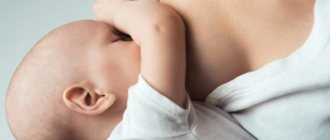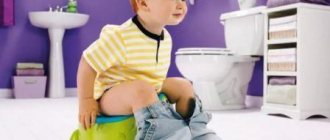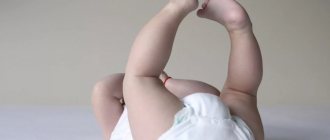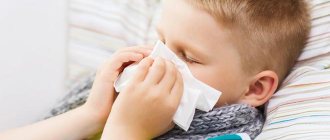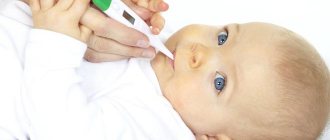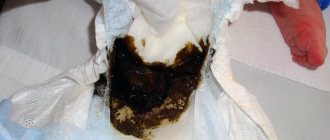What is diarrhea
With repeated excretion of stool in liquid form, doctors diagnose diarrhea. This is not an independent disease, but a symptom characteristic of pathologies of the intestines, stomach or pancreas. He indicates to the specialist that the person has had a disruption in the natural process of water absorption into the rectal mucosa, and destruction of the bonds between electrolytes.
Liquid green stool is conventionally divided into two subspecies. Acute diarrhea lasts no more than 2 weeks and accompanies the infection. In the chronic form, greenish-colored feces are released in a volume of at least 300 grams per day, and the number of visits to the toilet reaches 6–8 times. In this case, a sign of a serious disorder is a large number of undigested pieces of food.
Features of feces during breastfeeding
During the period when the child feeds exclusively on mother's milk, feces have their own characteristics. It can be yellow, dark mustard with white lumps and foam. The stool has the consistency of thick sour cream with a sour odor.
Up to 1.5 months, the frequency of bowel movements for a child is 5–12 times a day. As you get older, bowel movements become less frequent. By the age of three months, the baby’s stool frequency will be 4–6 times a day, for some it may even be up to 1 time.
Green diarrhea may develop due to changes in the composition of breast milk. If a woman’s diet changes periodically, the child’s body may react sharply to this and not absorb it properly. The situation is aggravated by the immaturity of the baby’s enzymatic system. In addition, feces tend to oxidize in air, so the color of the stool changes.
Causes of green diarrhea in children
Green diarrhea in a child begins suddenly and may be accompanied by complaints of abdominal pain, vomiting and other unpleasant symptoms. In most cases, the cause is hidden in infection with different types of pathogens:
- pathogenic fungi (yeast);
- bacteria;
- enteroviruses.
Such species provoke the development of intestinal infections associated with the activity of staphylococci, streptococci, and Pseudomonas aeruginosa. Upon contact with the intestinal mucous membranes, their active reproduction begins. They not only change the acidic environment of the epithelium, but also provoke the death of beneficial microflora, which is unstable in infancy.
Dysbacteriosis
Green diarrhea in children of the first year of life often occurs due to intestinal dysbiosis. The disease is increasingly being diagnosed in bottle-fed babies. It is associated with an imbalance of microflora and a significant increase in colonies of pathogenic microorganisms. At this age, the causes of pathology and diarrhea are as follows:
- improperly selected nutrition;
- allergy to milk proteins;
- antibiotic treatment.
In this case, the child’s green, loose stool is replaced by prolonged constipation, problems with bowel movements, and painful spasms. The disease can only be determined by a special stool analysis for the level of bifidobacteria, lactobacilli, and their concentration in the rectum.
Staphylococcus aureus
The dangerous bacterium is very common in the environment. It settles on the mucous membranes of the nose, genitals, and penetrates the intestines through the anus or esophagus. It is easy to infect a baby with daily care, during breastfeeding, or during the passage of the fetus through the birth canal. If a child has green diarrhea without fever, peeling or a rash on the skin of the abdomen, the pediatrician may refer you for stool tests.
The bacterium gradually infects the child’s internal organs and parasitizes their membranes. It is difficult to destroy by boiling or freezing. But its presence in the body negatively affects well-being:
- the child has diarrhea with greens several times a day;
- immunity is greatly reduced;
- food is practically not digested;
- there is a lack of vitamins and minerals.
Treatment of diarrhea in a one-month-old baby
If you have diarrhea, your baby should be given plenty of water.
No one is immune from various diseases, including defenseless children. A one-month-old baby has a vulnerable intestine, which can lead to digestive disorders.
Read: Water instead of feces, pathology or accident?
An ailment such as diarrhea can be easily treated at home. True, there are times when the help of a doctor is necessary.
First of all, when diarrhea is detected, it is necessary to give the child something to drink, since during the process of diarrhea, fluid is taken from the body.
Despite the baby’s gastrointestinal disorders, he also needs to eat. Mom will need to review her daily menu and make adjustments. Perhaps the nursing mother ate foods that cause a “laxative” effect.
If the child is bottle-fed, then you need to switch to another formula. The disease can also be treated with medications, but strictly as prescribed by the doctor. It is not advisable to give a one-month-old baby medication, but sometimes it is necessary.
Mild diarrhea lasts 2-3 days in infants. In this case, the stool turns green. This is how the intestines react to the introduction of new products into the diet or the composition of the dry mixture. It is advisable for nursing mothers to keep a food diary and track the reaction of the stool to the foods she eats. In case of artificial feeding, you just need to replace the formula.
If a month-old baby feels great with diarrhea, then there is no need to do anything. You will need to see a doctor in the following cases:
- Loose stools with bloody discharge
- Green stool with mucus
- Diarrhea accompanied by fever
- The disease began after taking prescribed medications
Breastfed babies are at the least risk of intestinal diseases. However, much depends on the diet of the nursing mother. If a mother eats prohibited foods while breastfeeding, then the beneficial properties of her milk will not be able to cope with the problems of the child’s digestive system.
Therefore, the most important moment in the first months of a child’s life is his nutrition. The more competently it is compiled, the healthier the baby’s gastrointestinal tract will be.
Learn how to stop diarrhea in a child from the video:
Read along with this article:
- Green poop in a baby: causes, methods...
- Why does a child poop often and how to help him in this case?
- Mucus in baby's stool: normal or pathological
- A newborn has a stomach ache, what to do, how to help and how to do it...
- Green feces in infants as a symptom of dysbiosis?
- A child has yellow diarrhea: when is this normal and when is it pathological?
- Note to mothers: normal stool in a newborn
- What causes diarrhea in a newborn, what to look for and...
- Baby's health: is it possible to give water to a baby?
Symptoms and dangers of green diarrhea in children
Many parents self-medicate, trying to normalize the baby’s condition with medications of their own choice. Therefore, diarrhea threatens to develop into a chronic form. To prevent inflammation, you need to pay attention to the following symptoms:
- the child has green diarrhea;
- I have a stomachache;
- the baby twists its legs, presses them to the navel;
- anxious and short sleep gives way to hysterics;
- vomit;
- temperature rise above 38°.
The presence of mucus indicates the development of an intestinal infection; rashes often appear with food allergies. Any symptoms require careful observation and mandatory treatment. Dark green diarrhea in a child can provoke the development of severe complications:
- Excessive loss of fluid during loose stools can lead to dehydration. This dangerously increases blood density and negatively affects the functioning of the brain, cardiovascular system, and kidneys.
- If food is not digested well enough, the body does not receive enough nutrients. The baby becomes lethargic, drowsy, and lacks energy for games, communication, and learning new knowledge.
- Growth slows down and weight loss begins.
Diarrhea with mucus in a child: causes and treatment
Diarrhea with mucus in a child is often accompanied by panic in the parents.
In a desire to help the baby, they begin independent treatment. At the same time, mistakes are often made that complicate the patient’s condition and can mask a dangerous disease. The best option is to understand the causes of diarrhea, provide the right help and consult a doctor.
Mucus is a natural substance in the digestive tract.
It is produced by goblet cells, which are located on the surface lining of the intestine.
The function of mucus is to moisturize and protect the internal surfaces of the intestines, improve the movement of food mass (chyme) and the breakdown of nutrients. The viscous mass is always excreted in small quantities in the feces, but is normally invisible.
Mucus becomes visible when there is excessive secretion into the intestinal lumen. It looks like a gel-like mass that can be transparent, red or green.
This occurs when there is spasm or inflammatory damage to the lining of the large intestine. At the same time, blood and pus may also be released in the stool.
Why does a child develop diarrhea with mucus? After damage to the mucous membranes, protein is released (exuded), water and electrolytes are “dumped” into the intestinal lumen. The stool becomes liquid.
Common reasons
In a child over 1 year old, mucus in diarrhea appears due to inflammation or functional disorder of the large intestine.
Causes:
- intestinal infections: salmonellosis, dysentery, yersiniosis, campylobacteriosis;
- irritable bowel syndrome;
- non-infectious colitis;
- Crohn's disease;
- diverticulitis;
- lactase deficiency;
- cystic fibrosis of the intestine;
- colon tumors;
- advanced helminthic infestation;
- abuse of enemas, suppositories.
Any infection, taking antibacterial medications, food and other poisoning, internal diseases can lead to dysbiosis with damage to the large intestine. In this case, yellow diarrhea with mucus is possible, but it appears later after the symptoms of the underlying pathology.
Mucus is characteristic of functional diarrhea, the cause of which is unknown. It is assumed that it is associated with the nervous regulation of the intestines. This disorder is characterized by periodic diarrhea for no apparent reason and other symptoms.
When a child has loose stools with mucus, you need to pay attention to the general condition and additional signs. Using them, you can determine the approximate cause of diarrhea and provide proper assistance to the patient.
Intestinal infections
They always begin with a deterioration in the general condition - the child loses activity, becomes apathetic and capricious.
Gradually the symptoms increase, the following appear:
- increase in body temperature from 37.5 to 40 °C;
- nausea, vomiting;
- rumbling in the stomach, flatulence;
- sharp abdominal pain;
- painful, false urge to go to the toilet;
- headache, muscle aches;
- blueness, paleness of the skin;
- convulsions, increased breathing, low blood pressure.
The stool is foul-smelling and frequent, from 5 to 25 times a day. It appears as yellow diarrhea, feces contain cloudy mucus, streaks of blood and greenish inclusions. On average, after 2 days, stool becomes scanty—“rectal spitting.”
Non-communicable diseases
Pathologies develop gradually, external manifestations are unnoticeable for a long time. These diseases can be accompanied by fever and occur without fever. Possible alternation of diarrhea and constipation.
Characteristic symptoms:
- abdominal pain: dull, aching, diffuse;
- false urge to defecate;
- decreased appetite, weight;
- flatulence, bloating;
- traces of blood on toilet paper;
- pain on palpation in the colon area;
- nausea, vomiting, general weakness.
Features of the stool: normal odor, watery, streaked with mucus and blood. A serious course of the disease is manifested by green diarrhea - a sign of purulent inflammation.
The appearance of diarrhea with mucus is a compelling reason to consult a doctor, regardless of additional symptoms. Each case is individual and may combine several violations. Only doctors can figure this out based on the results of tests and studies.
Ambulance at home
The most dangerous consequence of diarrhea is the loss of fluid and electrolytes, which can lead to heart failure. The younger the child, the faster dehydration develops. Therefore, children need to be given water at any intensity of diarrhea.
The best option is ready-made solutions:
- Hydrolyte;
- Oksolan;
- Regidron.
It is advisable to always have these products in your first aid kit. Homemade version: dissolve 1 tsp in 0.5 liters of water. salt, 2 tbsp. l. sugar, ½ tsp. baking soda, pre-slaked with boiling water.
Tea with 1 tsp is beneficial. sugar and dried fruit compote. Decoctions of raisins, carrots, and rice are used.
The child is fed fractionally. 50–100 ml for children under 2 years of age, 100–200 ml for adults after each bowel movement or vomiting. In case of intense diarrhea, drink 1–2 tsp. every 5–10 minutes.
Temperature does not pose a danger to the child; on the contrary, it reduces the effect of germs and toxins. It is knocked down only when the readings are above 38.1 °C and the child’s condition worsens due to fever.
It is permissible to give medications without a doctor:
- antipyretic suppositories: Efferalgan, Panadol, Tsefekon D (convenient for vomiting);
- Panadol or Ibuprofen in syrup form;
- sorbents: Smectu, Polyphepan.
Using certain medications can make diagnosis difficult and make a child's condition with diarrhea worse. This is a solution of potassium permanganate for enema and gastric lavage, activated carbon, any enzymes, antidiarrheal and antibacterial drugs.
Diagnostics
If the child feels unwell, call an ambulance. Doctors will determine the need for hospitalization, take measures to prevent complications and tell you about the procedure for further action.
When the child’s well-being allows it, they contact a pediatrician. The doctor will assess the child’s condition, find out the dietary habits, possible use of medications and study the history of early illnesses.
What tests are needed:
- general blood and urine tests;
- scatological examination of stool;
- blood chemistry;
- bacteriological study of feces and vomit;
- PCR analysis of feces and blood (if in doubt).
If gastrointestinal diseases are suspected, additional examination is prescribed:
- Ultrasound of the abdominal organs;
- colonoscopy;
- irrigoscopy;
- sigmoidoscopy;
- X-ray of the intestines.
For complicated infections, consultation with a cardiologist, nephrologist and urologist is necessary.
Diarrhea therapy
The main treatment is aimed at eliminating the disease - the cause of diarrhea. Loose stools with mucus in a child in the first 2 years are often caused by intestinal infections and dysbacteriosis.
Appropriate antiseptics and antibiotics are used:
- Furazolidone;
- Enterosediv;
- Sumetrolim;
- Gentamicin;
- Polymyxin M;
- Doxycycline (over 8 years);
- Chloramphenicol.
For the treatment of non-infectious diseases of the digestive system, drugs from the following groups are used: aminosalicylates, corticosteroids, cytostatics, TNF-α inhibitors. If necessary, physiotherapy, massage and therapeutic exercises are included. In advanced and complicated cases, surgery is necessary.
It doesn’t matter whether a child’s diarrhea is green with mucus or yellow. All types of diarrhea have common principles of treatment, which are aimed at eliminating symptoms and preventing complications.
Mandatory medications:
- sorbents: Smecta, Polyphepan, Filtrum, Enterosgel;
- enzymes: Creon, Panzinorm, Festal, Pepsin;
- probiotics: Acipol, Linex, Sporobacterin, Bifiform;
To alleviate the child's condition:
- severe colic: Gascon Drop, Espumisan, Bobotik;
- abdominal pain: Nurofen, No-Shpa;
- persistent vomiting: Riabal, Motilium;
- flatulence: dill water;
- high temperature: Panadol, Ibuprofen.
The type of medication, dosage and duration of treatment are determined by the doctor. Depends on the intensity of diarrhea, age and weight of the child.
The sick child is provided with comfortable conditions. Rest, regular ventilation of the room, and enhanced hygiene are required. Maternal care is of particular importance.
Nutrition
After the onset of diarrhea, the diet is adjusted. Food is steamed or boiled and fed 5-6 times a day in small portions. If there is persistent vomiting, there is no point in giving food - only liquid in large quantities. In other cases, they focus on appetite, but make sure that there are no “hungry” pauses for more than 4 hours.
The child must not:
- raw vegetables, sour berries and fruits (juices);
- fatty, pickled, salted, spicy, smoked dishes;
- whole milk;
- refined products;
- desserts, fresh pastries, black bread;
- legumes, nuts, mushrooms;
- oatmeal, millet, pearl barley porridge;
- lemonades.
For nutrition during the acute period of diarrhea, choose lean minced meat, porridge with water, light broths, bananas, baked apples without peel, crackers, and biscuits. Fermented milk products enhanced with lacto- or bifidobacteria are required.
Folk remedies
Herbal medicine is used after relief of acute diarrhea to restore the intestines. These are medications that have astringent and anti-inflammatory properties.
All remedies are taken 5-6 times a day. Children under 3 years old - 1 tsp, under 5 years old - 1 dessert spoon, older children - 1 tbsp. l. Treatment is continued for up to 30 days, the medications are changed every 10 days.
pharmaceutical camomile
Dried flowers (1 tablespoon) are poured with boiling water (100 ml), wrapped and left for 30 minutes. The cooled infusion is filtered.
Cinquefoil roots
The crushed raw materials (1 tsp) are poured with boiling water (200 ml) and kept in a water bath for 30 minutes. Do not cool, filter and add water to 200 ml.
St. John's wort (from 12 years old)
Dry herb (1.5 tbsp) is poured with boiling water (200 ml), heated in a water bath for 15 minutes, stirring occasionally. Cool and filter, add water to 200 ml.
Oak bark
Crushed bark (20 g) and boiled water (200 ml) are steamed in a water bath for half an hour. Strain while hot, dilute with water to the original volume.
After acute diarrhea, the child is given vitamins “Polivit”, “Supradin”, “Multitabs” for two weeks.
Diarrhea with mucus in a child 1 year of age or older is not a reason to panic, look for reasons and think about the bad. The parents' frustration is noticeable to the children, which affects the general well-being of the patient. Therefore, you need to remain calm - provide first aid and consult a doctor.
Source: https://bezponosa.ru/u-detey/ponos-so-slizyu-u-rebenka.html
How to provide first aid to a child
If a child has green diarrhea and fever, it is necessary to call an ambulance to alleviate the baby’s condition as follows:
- Rinse the stomach with clean water at room temperature, induce vomiting by pressing on the base of the tongue.
- If there is no vomiting, give clean water without gas.
- Avoid any foods, milk, or sweets until consulting a doctor.
- A one-year-old child is given a light formula of no more than 50 ml at a time, being careful not to overload the stomach.
- At temperatures above 38°, you can give a dose of Paracetamol or Ibuprofen.
- Wipe the baby with water, moisten your lips more often.
It is possible to select a more precise treatment only after tests for microflora, staphylococcus, and ultrasound of internal organs. It is necessary to exclude gastric bleeding, an attack of appendicitis or severe indigestion.
Features of the treatment of green diarrhea in children
Vomiting and green diarrhea in a child can lead to dehydration, so it is necessary to monitor the condition and well-being. In newborns, when the water balance is critically low, the “fontanel”, an unossified area on the top of the head, begins to sink. Blood vessels appear in it, their pulsation becomes noticeable.
How to treat green diarrhea in a child depends on the situation and symptoms:
- For intestinal infections, special antibiotics are needed: Enterofuril, Loperamide.
- To reduce intoxication, sorbents are recommended: Polysorb, activated carbon, Atoxyl.
- To eliminate dehydration, it is necessary to give a small portion of special drugs for rehydration every 15–30 minutes: Regidron, Reoxolan, Glucosolan.
- Green diarrhea and fever are very debilitating, so you can give antipyretic drugs 2 times a day: Panadol, Paracetamol, Nurofen.
Dysbacteriosis requires the use of special agents that normalize the microflora. If a child's green diarrhea without fever was caused by the development of this disease, for several weeks the baby should be given Linex, Bifidumbacterin, Acipol, Biobakton, Bifiform, and fermented milk mixtures from medicinal series should be introduced into the diet.
Intestines of a one-month-old baby
Infants often experience constipation and colic.
In the first month of his life, the baby is just beginning to adapt to the new world. In his mother's tummy, while still a fetus, he received nutrients in a different way.
True, during the development of the baby in the stomach and in the period after his birth, nutrition is closely related to the mother’s diet.
The intestines of infants are special and require a gentle attitude. Therefore, in order to avoid serious problems with the baby’s tummy, a nursing mother must adhere to a strict diet in the first three months of the child’s life. Children's intestines often cause concern among parents. This is due to the following ailments:
- Bloating
- Colic
- Constipation
- Diarrhea
- Stool color
A baby's intestines are longer than those of an adult. It rests on the mesentery. In premature babies, the location of the intestinal system is often atypical. Compared to the adult intestine, the children's intestine has a number of features:
- High sterility at birth
- High permeability of nutrients entering the blood
- High mobility
A baby is born with a completely sterile intestine. However, later it becomes populated by microbes. The number of microorganisms depends on the following factors:
- Feeding method
- The state of the microflora of the baby and mother
- The baby's use of various medications
If a child is breastfed, bifidobacteria appear in the intestines. With artificial feeding, lactobacilli predominate. With the introduction of complementary foods, E. coli appear.
Microbes such as saprophytes help the body in the process of digesting food, and also contribute to the release of B vitamins. However, such beneficial microbes have representatives that can harm the intestines when they multiply.
Disorders of microorganisms can lead to dysbacteriosis. The occurrence of such a disease is possible after intensive therapy and taking potent medications. In this case, doctors usually prescribe probiotics for children.
Read: How dangerous is diarrhea in a 3 month old baby?
In the first days of life, the newborn empties a thick, dark brown mass. Subsequently, the stool may be green, then yellow with a porridge-like consistency. The intestines of a breastfed baby react sharply to the mother's nutrition.
Therefore, his stool may contain lumps, green impurities, etc. Foamy stools most often indicate that the baby did not finish the milk, thereby not waiting for the most nutritious “back”.
After the introduction of complementary foods, the baby's stool begins to become more and more similar to the stool of an adult.
Nutrition for diarrhea
If you have indigestion, you should choose a light and balanced diet. All food should be in the form of a light puree without butter or sour cream. Fats, sweet desserts, and any foods that can increase fermentation in the intestines are temporarily excluded: smoked foods, cabbage, yogurt, and baked goods. The best options to reduce green diarrhea with mucus in a child:
- steamed chicken meat, ground into pate;
- boiled vegetables (potatoes, carrots, broccoli);
- steam omelettes and soufflés;
- rice or oatmeal;
- low-fat broth;
- egg yolk.
After a period of exacerbation with diarrhea, the child’s diet is supplemented with baked vegetables and fruits, fermented milk products, jelly or fruit juice from seasonal berries are gradually introduced. Instead of sweets, dried bread, bagels or crackers are allowed.
Baby's nutrition in the first month
Proper nutrition for a baby is very important.
The first time after birth, the baby is weakened and needs to get used to a new way of life. His intestinal system especially needs adaptation.
Therefore, a mother needs to approach the issue of feeding her child with all responsibility. The baby eats what his mother eats when breastfeeding or dry formula.
In the first months of life, it is advisable for the baby to eat mother's milk. Indeed, unlike mixtures, it contains all the useful and nutrient substances that increase the child’s immunity. And if the mother has chosen a natural method of feeding, then she should pay close attention to her diet, especially in the first month of the baby’s life.
At first, the baby eats up to 30 ml of milk. At the same time, if the baby demands more, you should not refuse him. During the first month the baby is advised to feed on demand. The more often the mother puts the baby to the breast, the more milk she will produce.
The child’s intestines are just beginning to work, so it should not be “loaded” with heavy food. In the first month of breastfeeding, mothers should exclude the following foods from their diet:
- Cow's milk
- Fermented milk products more than 200 ml per day and containing a high percentage of fat content
- Fried, spicy, smoked food
- Pickles, jams
- Red berries and fruit juice made from them
- Legumes
- Vegetables (except boiled potatoes and carrots)
- Fruits and fruit juices
- Black tea and coffee
- Sweets
- Flour products (except crackers and stale bread)
Read: Diarrhea after gallbladder removal: how to return to normal life?
At the same time, no matter how strict a diet the mother is on, the baby’s intestines are vulnerable, which provokes colic. Such a disease is inevitable in almost every child. The stomach bothers the baby until about 3 months of age.
Colic can be relieved by special medications, gymnastics, abdominal massage and placing a warm diaper on the stomach. However, it is impossible to completely get rid of pain. Parents just need to be patient.
Traditional methods and recipes
Green diarrhea in a one-month-old baby should be treated only under the supervision of a specialist. For school-age children, taking medications can be supplemented with traditional methods. At home, Regidron for dehydration is replaced with the following composition:
- 0.5 l of boiled water;
- 15 g sugar;
- 10 g salt.
After stirring, the composition is drunk in small portions of 100 ml at intervals of 20–30 minutes. Useful plants from which it is recommended to prepare a decoction for drinking against diarrhea:
- oak bark;
- pharmaceutical camomile;
- blueberries;
- flax seeds;
- chicory.
Prevention
In most cases, green diarrhea is a consequence of the activity of bacteria and microorganisms. Therefore, parents should carefully monitor the hygiene of infants and adhere to the following recommendations:
- Thoroughly wash and treat feeding utensils and wash your breasts before expressing.
- Select formulas and complementary foods together with your doctor.
- Wash and disinfect toys more often, and keep the room clean.
- Do not overload children’s stomachs with fatty, smoked and fast food products.
From preschool age, parents need to be shown by personal example how to keep their hands, body, and clothes clean. Proper nutrition and a balanced menu in accordance with age will help avoid digestive problems.
